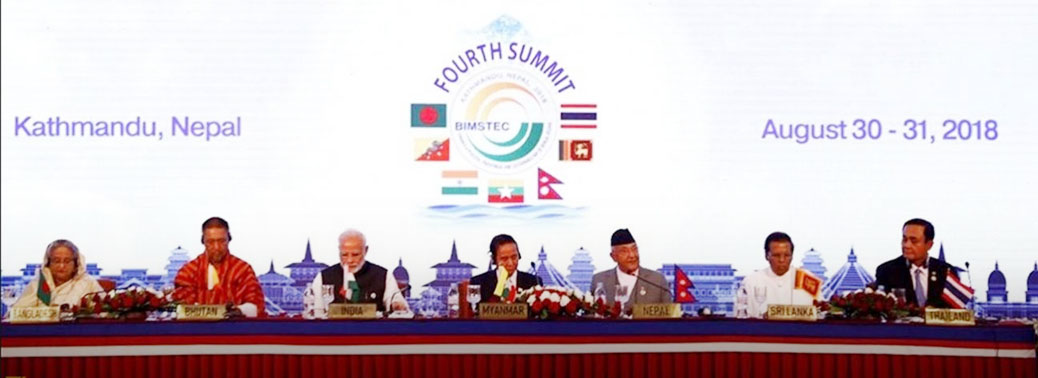BIMSTEC envoys bat for FTA
06, Aug 2018

Prelims level :
Mains level : Paper – II Bilateral Regional & Global Grouping and Agreements
BIMSTEC called for the speedy conclusion of a Free Trade Agreement within the group comprising Bangladesh, Bhutan, India, Nepal, Sri Lanka, Myanmar and Thailand.
Economic Potential:
- There is scope for both land and maritime connectivity that can enhance their trade, incomes, and welfare.
- The BIMSTEC region is home to around 1.5 billion people which constitute around 22% of the global population with a combined gross domestic product (GDP) of 2.7 trillion economy.
- The region has a diverse socioeconomic setup, including major economic powers such as India. It also has a large young demographic, in search of employment.
- lack of trust among the member countries of SAARC has been the most significant factor for failure of SAARC which creates the need for BIMSTEC
- BIMSTEC is a unique regional cooperation initiative in terms of geographical contiguity and spread, natural resources and the vast combined labour force of its member states.
Issues:
- Despite its huge potential in terms of enhancing regional cooperation between parts of South and Southeast Asia, BIMSTEC has long suffered from lack of resources and proper coordination among its member states.
- Infrastructure and connectivity are the core elements of trade facilitation at the borders. Lack of telecommunication links, parking space, cold storages, facilities for truck drivers in-transit, and regular power supply are the major problems that hinder the smooth flow of trade between the member countries.
- The region has low purchasing power, with four members in the LDC category with high poverty levels.
- Even though there are complementarities in the exports and imports of the member countries, intra-regional trade is low due to many hurdles like tariff barriers, lack of connectivity and transportation problems. Some of the export items of one country within BIMSTEC are the main import items of another member.
- There are many supply-side constraints in the smaller countries of the group. With limited production capacity, they are unable to meet the demand generated by larger member economies.
- Lack of industrialisation is an important reason for low production capacity in some LDCs.
- The costs of transportation and logistics are high.
- The trade is dominated by low-technology tradable products.
- There is an absence of a strong regional value chain.
- The trade is limited to only a few product categories.
- A substantial amount of informal trade takes place across the borders of India and its neighbouring countries which is not accounted for in trade statistics.
Way Forward:
- FTA will help members to liberalise and harmonise their investment regimes and fiscal policy structures.
- If the Northeast manages to nurture stronger links with India’s neighbouring countries to the east, it will lead to a higher degree of integration with them, facilitating trade and development as well as attracting foreign investment.
- Connectivity particularly digital connectivity and backend infrastructure needs to be improved
- With BIMSTEC, hopes are higher that the sub-regional cooperation will be more of a success, and that BIMSTEC FTA can replace SAFTA.
BIMSTEC:
- The Bay of Bengal Initiative for Multi-Sectoral Technical and Economic Cooperation (BIMSTEC) is a regional organization comprising seven Member States lying in the littoral and adjacent areas of the Bay of Bengal constituting a contiguous regional unity.
- This sub-regional organization came into being on 6 June 1997 through the Bangkok Declaration.
- It constitutes seven Member States: five deriving from South Asia, including Bangladesh, Bhutan, India, Nepal, Sri Lanka, and two from Southeast Asia, including Myanmar and Thailand.
- Initially, the economic bloc was formed with four Member States with the acronym ‘BIST-EC’ (Bangladesh, India, Sri Lanka and Thailand Economic Cooperation).
- Following the inclusion of Myanmar on 22 December 1997 during a special Ministerial Meeting in Bangkok, the Group was renamed ‘BIMST-EC’ (Bangladesh, India, Myanmar, Sri Lanka and Thailand Economic Cooperation).
- With the admission of Nepal and Bhutan at the 6th Ministerial Meeting (February 2004, Thailand), the name of the grouping was changed to ‘Bay of Bengal Initiative for Multi-Sectoral Technical and Economic Cooperation’ (BIMSTEC).
- The regional group constitutes a bridge between South and South East Asia and represents a reinforcement of relations among these countries.






